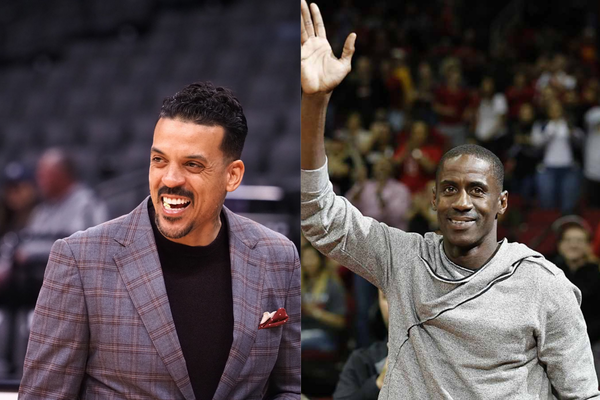
via Imago
A collage featuring Matt Barnes and Vernon Maxwell

via Imago
A collage featuring Matt Barnes and Vernon Maxwell
Imagine stepping onto the court as a 17-year-old freshman, still growing into your frame, only to face a 26-year-old seasoned veteran with years of experience and physical maturity on his side. That’s exactly the kind of matchup the NCAA is producing today.
On 31 December 2024, 26-year-old Trevin Knell was part of the BYU Cougars side that won 76-56 over Arizona State – facing off against 17-year-old freshman Jayden Quaintance, one of the youngest players in the country. The contrast was glaring. One player was at the tail end of his collegiate career, the other barely old enough to vote.
This trend is not merely a statistical anomaly; it’s fundamentally altering the landscape of college basketball. When a 26-year-old is outmuscling and outsmarting a 17-year-old, is it really about talent or just years of extra growth and experience?
ADVERTISEMENT
Article continues below this ad
What’s your perspective on:
Should NCAA basketball have an age cap to prevent 26-year-olds from overpowering 17-year-old freshmen?
Have an interesting take?
Recently, a clip from the All The Smoke podcast featuring Matt Barnes went viral on Instagram. In the clip, Barnes voiced his frustration over the growing age disparity in college basketball, emphasizing the need for an age cap. “I definitely think that there has to be some sorta age limit set. I mean 17. Some guys are coming in at 17, a little younger. But 23. I think 24 has to kinda be the cap,” he stated.
View this post on Instagram
Upon hearing this, Vernon Maxwell, agitated, said, “Man you got to put an age limit on that shit man. You got 27-year-old mot———s and s–t.” He spoke candidly about the upper limit of the ages of the players playing college basketball. And it’s not just basketball in the NCAA that’s suffering; wrestling, an even more physical sport, faces the same problem.
Barnes made it clear that he doesn’t blame the players or coaches, acknowledging that older athletes play a crucial role in their team’s success. However, he highlighted the stark physical differences between younger and older players. “We know how big a difference between an 18-year-old body and a 22-year-old to a 24-year-old body. At 26, you’re coming into your man, you’re hitting your prime at 26-27-28 as an actual man. To think about that playing against, you know, kids who are 17, 18, it doesn’t make sense to me.”
While Barnes supports athletes staying in school for education, he believes it shouldn’t interfere with the integrity of the game. Can implementing an age cap to maintain competitive balance be a solution?
This isn’t just a minor inconvenience—it’s a fundamental issue that reshapes competition at the college level. The NCAA’s current eligibility rules make it possible for teams to stack their rosters with physically mature players in their mid-20s, drastically shifting the balance of power on the court
The age issue: What is Matt Barnes really talking about?
Here’s the problem: Some college teams are older than actual NBA rosters. No joke, Auburn’s 25-year-old Chad Baker-Mazara is older than 36% of OKC’s current roster. Let that sink in. That’s a full-fledged NBA team, younger than a college team. That’s not just a small gap; a fully developed athlete overmatches someone still growing into their body.
This dynamic also distorts evaluation. Scouts and front offices must decide whether an older player’s dominance in college is due to skill or sheer physical advantage. Meanwhile, younger prospects often struggle to shine against seasoned opponents, potentially causing NBA teams to undervalue their long-term potential.

via Getty
PROVO, UT – JANUARY 23 : Noah Waterman #0 of the Brigham Young Cougars warms up before their game against the Houston Cougars at the Marriott Center on January 23, 2024 in Provo, Utah. (Photo by Chris Gardner/Getty Images)
And there are countless examples of older players running the show. Parker Fox of the Minnesota Gophers is 26, Golden Griffins’ Jasman Sangha is 25, and Le Moyne’s Roby Carmody is 25 (set to turn 26 in May).
ADVERTISEMENT
Article continues below this ad
ADVERTISEMENT
Article continues below this ad
What’s worse than a talent gap? A talent gap that distorts the entire evaluation process. When older players outmuscle their younger counterparts, it’s not just an issue on the court – it’s a problem for scouts, coaches, and the future of the NBA. Players who should shine based on potential are overshadowed by older “prospects” with years of extra growth. If the NCAA continues to allow this, it risks misjudging the very players who will shape the future of the game.
ADVERTISEMENT
ADVERTISEMENT
ADVERTISEMENT
ADVERTISEMENT


Should NCAA basketball have an age cap to prevent 26-year-olds from overpowering 17-year-old freshmen?